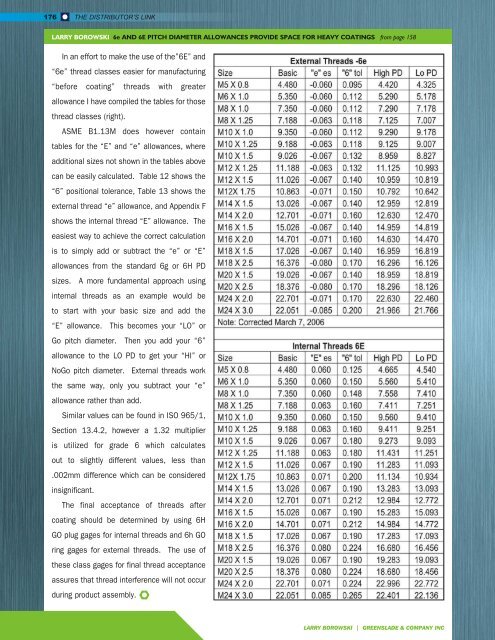SUMMER 2018
Distributor's Link Magazine Summer 2018 / Vol 41 No3
Distributor's Link Magazine Summer 2018 / Vol 41 No3
Create successful ePaper yourself
Turn your PDF publications into a flip-book with our unique Google optimized e-Paper software.
176<br />
THE DISTRIBUTOR’S LINK<br />
LARRY BOROWSKI 6e AND 6E PITCH DIAMETER ALLOWANCES PROVIDE SPACE FOR HEAVY COATINGS from page 158<br />
In an effort to make the use of the”6E” and<br />
“6e” thread classes easier for manufacturing<br />
“before coating” threads with greater<br />
allowance I have compiled the tables for those<br />
thread classes (right).<br />
ASME B1.13M does however contain<br />
tables for the “E” and “e” allowances, where<br />
additional sizes not shown in the tables above<br />
can be easily calculated. Table 12 shows the<br />
“6” positional tolerance, Table 13 shows the<br />
external thread “e” allowance, and Appendix F<br />
shows the internal thread “E” allowance. The<br />
easiest way to achieve the correct calculation<br />
is to simply add or subtract the “e” or “E”<br />
allowances from the standard 6g or 6H PD<br />
sizes. A more fundamental approach using<br />
internal threads as an example would be<br />
to start with your basic size and add the<br />
“E” allowance. This becomes your “LO” or<br />
Go pitch diameter. Then you add your “6”<br />
allowance to the LO PD to get your “HI” or<br />
NoGo pitch diameter. External threads work<br />
the same way, only you subtract your “e”<br />
allowance rather than add.<br />
Similar values can be found in ISO 965/1,<br />
Section 13.4.2, however a 1.32 multiplier<br />
is utilized for grade 6 which calculates<br />
out to slightly different values, less than<br />
.002mm difference which can be considered<br />
insignificant.<br />
The final acceptance of threads after<br />
coating should be determined by using 6H<br />
GO plug gages for internal threads and 6h GO<br />
ring gages for external threads. The use of<br />
these class gages for final thread acceptance<br />
assures that thread interference will not occur<br />
during product assembly.<br />
LARRY BOROWSKI | GREENSLADE & COMPANY INC

















